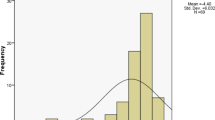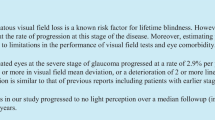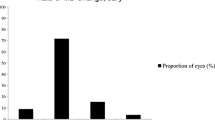Abstract
Purpose
This study aims to determine the 5-year visual field progression and identify the prognostic factors for progression in Malay patients with primary glaucoma.
Methods
A retrospective cohort record review study was conducted among 222 patients (222 eyes) with primary glaucoma who were selected from a glaucoma research database of a tertiary center in Malaysia. The patients were Malays and diagnosed with primary open-angle glaucoma (POAG) or primary angle-closure glaucoma (PACG). Patients who were followed up regularly for at least 6 months between 1 January 2009 and 31 December 2014 and completed another 1-year follow-up after recruitment (between 1 January 2015 and 31 December 2015) were selected. Multiple prognostic factors that influence visual field progression were identified. Progression of visual field loss was based on the Advanced Glaucoma Intervention Study and Hodapp–Parrish–Anderson scores. Kaplan–Meier survival and Cox proportional hazard regression analyses were performed.
Results
Sixty-three patients (28.4%) developed visual field progression after a mean (SD) follow-up of 6.9 (3.3) years. Those with POAG progressed faster (mean time, 10.6 years; 95% confidence interval [CI], 9.3, 11.9) than those with PACG (17.3 years; 95% CI, 14.8, 19.9) but not statistically significant. Disc hemorrhage and history of eye pain increased the risk of progression by 2.8-folds (95% CI, 1.6, 4.8) and 2.5-folds (1.4, 4.4), respectively.
Conclusion
The 5-year survival of the Malay primary glaucoma patients with visual field progression was similar with that of other Asian populations. However, aggressive management is required for those with disc hemorrhages and eye pain related to increased intraocular pressure.


Similar content being viewed by others
Data availability
The data sets generated during and/or analyzed during the current study are available from the corresponding author on reasonable request.
Code availability
Not applicable.
References
Worldometer (2021) Asia population (live). https://www.worldometers.info/world-population/asia-population/ Accessed 7 Aug 2021
Chen PP (2003) Blindness in patients with treated open-angle glaucoma. Ophthalmology 110:726–733. https://doi.org/10.1016/S0161-6420(02)01974-7
Resnikoff S, Pascolini D, Etya’ale D, Kocur I, Pararajasegaram R, Pokharel GP, Mariotti SP (2004) Global data on visual impairment in the year 2002. Bull World Health Organ 82:844–851. https://doi.org/10.1590/S0042-96862004001100009
Quigley HA, Broman AT (2006) The number of people with glaucoma worldwide in 2010 and 2020. Br J Ophthalmol 90:262–267. https://doi.org/10.1136/bjo.2005.081224
Rao A (2012) Blindness and long-term progression of visual field defects in Chinese patients with primary angle-closure glaucoma. Am J Ophthalmol 153: 382; author reply 382–383. https://doi.org/10.1016/j.ajo.2011.11.013
Stein JD, Kim DS, Niziol LM, Talwar N, Nan B, Musch DC, Richards JE (2011) Differences in rates of glaucoma among Asian Americans and other racial groups, and among various Asian ethnic groups. Ophthalmology 118:1031–1037. https://doi.org/10.1016/j.ophtha.2010.10.024
US Census Bureau (2021) Malaysia. https://www.census.gov/popclock/world/my Accessed 1 July 2021
Wikipedia (2021) Malays (ethnic group). https://en.wikipedia.org/wiki/Malays_(ethnic_group) Accessed 23 September 2021
Hung KH, Cheng CY, Liu CJ (2015) Risk factors for predicting visual field progression in Chinese patients with primary open-angle glaucoma: a retrospective study. J Chin Med Assoc 78:418–423. https://doi.org/10.1016/j.jcma.2015.02.004
Sakata R, Yoshitomi T, Iwase A, Matsumoto C, Higashide T, Shirakashi M, Aihara M, Sugiyama K, Araie M, Lower Normal Pressure Glaucoma Study Members in Japan Glaucoma S (2019) Factors associated with progression of Japanese open-angle glaucoma with lower normal intraocular pressure. Ophthalmology 126: 1107-1116. https://doi.org/10.1016/j.ophtha.2018.12.029
Gothwal VK, Reddy SP, Bharani S, Bagga DK, Sumalini R, Garudadri CS, Rao HL, Senthil S, Pathak-Ray V, Mandal AK (2012) Impact of glaucoma on visual functioning in Indians. Invest Ophthalmol Vis Sci 53:6081–6092. https://doi.org/10.1167/iovs.12-9885
Rosman M, Zheng Y, Lamoureux E, Saw SM, Aung T, Tay WT, Wang JJ, Mitchell P, Tai ES, Wong TY (2012) Review of key findings from the Singapore Malay Eye Study (SiMES-1). Singapore Med J 53:82–87
Chew FLM, Salowi MA, Mustari Z, Husni MA, Hussein E, Adnan TH, Ngah NF, Limburg H, Goh PP (2018) Estimates of visual impairment and its causes from the National Eye Survey in Malaysia (NESII). PLoS ONE 13:e0198799. https://doi.org/10.1371/journal.pone.0198799
Department of Statistics Malaysia Official Portal (2021) Current population estimates, Malaysia, 2021.https://www.dosm.gov.my/v1/index.php?r=column/cthemeByCat&cat=155&bul_id=ZjJOSnpJR21sQWVUcUp6ODRudm5JZz09&menu_id=L0pheU43NWJwRWVSZklWdzQ4TlhUUT09. Accessed 15 July 2021
Population C (2010) Kelantan. https://www.citypopulation.de/en/malaysia/admin/03__kelantan/. Accessed 6 July 2021
(2017) European Glaucoma Society Terminology and Guidelines for Glaucoma, 4th Edition - Chapter 2: Classification and terminology supported by the EGS Foundation: Part 1: Foreword; Introduction; Glossary; Chapter 2 Classification and Terminology. Br J Ophthalmol 101: 73–127. https://doi.org/10.1136/bjophthalmol-2016-EGSguideline.002
Foster PJ, Buhrmann R, Quigley HA, Johnson GJ (2002) The definition and classification of glaucoma in prevalence surveys. Br J Ophthalmol 86:238–242. https://doi.org/10.1136/bjo.86.2.238
Birt CM, Shin DH, Samudrala V, Hughes BA, Kim C, Lee D (1997) Analysis of reliability indices from Humphrey visual field tests in an urban glaucoma population. Ophthalmology 104:1126–1130. https://doi.org/10.1016/s0161-6420(97)30173-0
Banes MJ, Culham LE, Bunce C, Xing W, Viswanathan A, Garway-Heath D (2006) Agreement between optometrists and ophthalmologists on clinical management decisions for patients with glaucoma. Br J Ophthalmol 90:579–585. https://doi.org/10.1136/bjo.2005.082388
AGIS (2000) The Advanced Glaucoma Intervention Study (AGIS): 7. The relationship between control of intraocular pressure and visual field deterioration. The AGIS Investigators Am J Ophthalmol 130:429–440. https://doi.org/10.1016/s0002-9394(00)00538-9
Zhang X, Dastiridou A, Francis BA, Tan O, Varma R, Greenfield DS, Schuman JS, Huang D, Advanced Imaging for Glaucoma Study G (2017) Comparison of glaucoma progression detection by optical coherence tomography and visual field. Am J Ophthalmol 184: 63-74. https://doi.org/10.1016/j.ajo.2017.09.020
McCarty CA, Nanjan MB, Taylor HR (2001) Vision impairment predicts 5 year mortality. Br J Ophthalmol 85:322–326. https://doi.org/10.1136/bjo.85.3.322
Zahari M, Mukesh BN, Rait JL, Taylor HR, McCarty CA (2006) Progression of visual field loss in open angle glaucoma in the Melbourne Visual Impairment Project. Clin Exp Ophthalmol 34:20–26. https://doi.org/10.1111/j.1442-9071.2006.01142.x
Stel VS, Dekker FW, Tripepi G, Zoccali C, Jager KJ (2011) Survival analysis I: the Kaplan-Meier method. Nephron Clin Pract 119:c83-88. https://doi.org/10.1159/000324758
Gardiner SK, Crabb DP (2002) Frequency of testing for detecting visual field progression. Br J Ophthalmol 86:560–564. https://doi.org/10.1136/bjo.86.5.560
Dong ZM, Wollstein G, Schuman JS (2016) Clinical utility of optical coherence tomography in glaucoma. Invest Ophthalmol Vis Sci 57: OCT556–567. https://doi.org/10.1167/iovs.16-19933
Feiner L, Piltz-Seymour JR, Treatment CIG, S, (2003) Collaborative Initial Glaucoma Treatment Study: a summary of results to date. Curr Opin Ophthalmol 14:106–111
Leske MC, Heijl A, Hyman L, Bengtsson B (1999) Early Manifest Glaucoma Trial: design and baseline data. Ophthalmology 106:2144–2153. https://doi.org/10.1016/s0161-6420(99)90497-9
Hattenhauer MG, Johnson DH, Ing HH, Herman DC, Hodge DO, Yawn BP, Butterfield LC, Gray DT (1998) The probability of blindness from open-angle glaucoma. Ophthalmology 105:2099–2104. https://doi.org/10.1016/S0161-6420(98)91133-2
Kwon YH, Kim CS, Zimmerman MB, Alward WL, Hayreh SS (2001) Rate of visual field loss and long-term visual outcome in primary open-angle glaucoma. Am J Ophthalmol 132:47–56. https://doi.org/10.1016/s0002-9394(01)00912-6
Pereira ML, Kim CS, Zimmerman MB, Alward WL, Hayreh SS, Kwon YH (2002) Rate and pattern of visual field decline in primary open-angle glaucoma. Ophthalmology 109:2232–2240. https://doi.org/10.1016/s0161-6420(02)01248-4
Musch DC, Gillespie BW, Lichter PR, Niziol LM, Janz NK, Investigators CS (2009) Visual field progression in the Collaborative Initial Glaucoma Treatment Study the impact of treatment and other baseline factors. Ophthalmology 116:200–207. https://doi.org/10.1016/j.ophtha.2008.08.051
Boland MV, Zhang L, Broman AT, Jampel HD, Quigley HA (2008) Comparison of optic nerve head topography and visual field in eyes with open-angle and angle-closure glaucoma. Ophthalmology 115(239–245):e232. https://doi.org/10.1016/j.ophtha.2007.03.086
Yousefi S, Sakai H, Murata H, Fujino Y, Garway-Heath D, Weinreb R, Asaoka R (2018) Asymmetric patterns of visual field defect in primary open-angle and primary angle-closure glaucoma. Invest Ophthalmol Vis Sci 59:1279–1287. https://doi.org/10.1167/iovs.17-22980
BallaeGaneshrao S, Senthil S, Choudhari N, Sri Durgam S, Garudadri CS (2019) Comparison of visual field progression rates among the high tension glaucoma, primary angle closure glaucoma, and normal tension glaucoma. Invest Ophthalmol Vis Sci 60:889–900. https://doi.org/10.1167/iovs.18-25421
Lee YH, Kim CS, Hong SP (2004) Rate of visual field progression in primary open-angle glaucoma and primary angle-closure glaucoma. Korean J Ophthalmol 18:106–115. https://doi.org/10.3341/kjo.2004.18.2.106
Aung T, Ang LP, Chan SP, Chew PT (2001) Acute primary angle-closure: long-term intraocular pressure outcome in Asian eyes. Am J Ophthalmol 131:7–12. https://doi.org/10.1016/s0002-9394(00)00621-8
Aung T, Friedman DS, Chew PT, Ang LP, Gazzard G, Lai YF, Yip L, Lai H, Quigley H, Seah SK (2004) Long-term outcomes in Asians after acute primary angle closure. Ophthalmology 111:1464–1469. https://doi.org/10.1016/j.ophtha.2003.12.061
Liza-Sharmini AT, Sharina YN, Dolaboladi AJ, Zaid NA, Azhany Y, Zunaina E (2014) Clinical presentation, severity and progression of primary angle closure in Malays. Med J Malaysia 69:21–26
Sharmini AT, Yin NY, Lee SS, Jackson AL, Stewart WC (2009) Mean target intraocular pressure and progression rates in chronic angle-closure glaucoma. J Ocul Pharmacol Ther 25:71–75. https://doi.org/10.1089/jop.2008.0061
Quek DTL, Koh VT, Tan GS, Perera SA, Wong TT, Aung T (2011) Blindness and long-term progression of visual field defects in Chinese patients with primary angle-closure glaucoma. Am J Ophthalmol 152:463–469. https://doi.org/10.1016/j.ajo.2011.02.023
Congdon N, Wang F, Tielsch JM (1992) Issues in the epidemiology and population-based screening of primary angle-closure glaucoma. Surv Ophthalmol 36:411–423. https://doi.org/10.1016/s0039-6257(05)80022-0
Anton A, Andrada MT, Mujica V, Calle MA, Portela J, Mayo A (2004) Prevalence of primary open-angle glaucoma in a Spanish population: the Segovia study. J Glaucoma 13:371–376. https://doi.org/10.1097/01.ijg.0000133385.74502.29
De Moraes CG, Liebmann JM, Levin LA (2017) Detection and measurement of clinically meaningful visual field progression in clinical trials for glaucoma. Prog Retin Eye Res 56:107–147. https://doi.org/10.1016/j.preteyeres.2016.10.001
De Moraes CG, Liebmann JM, Greenfield DS, Gardiner SK, Ritch R, Krupin T, Low-pressure Glaucoma Treatment Study G (2012) Risk factors for visual field progression in the low-pressure glaucoma treatment study. Am J Ophthalmol 154: 702-711. https://doi.org/10.1016/j.ajo.2012.04.015
Spry PG, Sparrow JM, Diamond JP, Harris HS (2005) Risk factors for progressive visual field loss in primary open angle glaucoma. Eye (Lond) 19:643–651. https://doi.org/10.1038/sj.eye.6701605
Drance S, Anderson DR, Schulzer M, Collaborative Normal-Tension Glaucoma Study G (2001) Risk factors for progression of visual field abnormalities in normal-tension glaucoma. Am J Ophthalmol 131: 699-708. https://doi.org/10.1016/s0002-9394(01)00964-3
Leske MC, Heijl A, Hussein M, Bengtsson B, Hyman L, Komaroff E (2003) Factors for glaucoma progression and the effect of treatment: the early manifest glaucoma trial. Arch Ophthalmol 121:48–56. https://doi.org/10.1001/archopht.121.1.48
Law SK, Choe R, Caprioli J (2001) Optic disk characteristics before the occurrence of disk hemorrhage in glaucoma patients. Am J Ophthalmol 132:411–413. https://doi.org/10.1016/s0002-9394(01)01009-1
Kim KE, Jeoung JW, Kim DM, Ahn SJ, Park KH, Kim SH (2015) Long-term follow-up in preperimetric open-angle glaucoma: progression rates and associated factors. Am J Ophthalmol 159(160–168):e161-162. https://doi.org/10.1016/j.ajo.2014.10.010
Kass MA, Heuer DK, Higginbotham EJ, Johnson CA, Keltner JL, Miller JP, Parrish RK, 2nd, Wilson MR, Gordon MO (2002) The ocular hypertension treatment study: a randomized trial determines that topical ocular hypotensive medication delays or prevents the onset of primary open-angle glaucoma. Arch Ophthalmol 120: 701–713; discussion 829–730. https://doi.org/10.1001/archopht.120.6.701
Quigley HA (2005) European glaucoma prevention study. Ophthalmology 112: 1642–1643; author reply 1643–1645. https://doi.org/10.1016/j.ophtha.2005.05.024
Seol BR, Jeoung JW, Park KH (2019) Ocular and systemic risk factors associated with recurrent disc hemorrhage in primary open-angle glaucoma. PLoS ONE 14:e0222166. https://doi.org/10.1371/journal.pone.0222166
Siam GA, de Barros DS, Gheith ME, Da Silva RS, Lankaranian D, Tittler EH, Myers JS, Spaeth GL (2007) The amount of intraocular pressure rise during pharmacological pupillary dilatation is an indicator of the likelihood of future progression of glaucoma. Br J Ophthalmol 91:1170–1172. https://doi.org/10.1136/bjo.2007.116855
Leibowitz HM (2000) The red eye. N Engl J Med 343:345–351. https://doi.org/10.1056/NEJM200008033430507
Walland MJ (2008) On the lookout: how to save the sight of Australians who have glaucoma. Med J Aust 188:269–270. https://doi.org/10.5694/j.1326-5377.2008.tb01616.x
Chew SS, Vasudevan S, Patel HY, Gurria LU, Kerr NM, Gamble G, Crowston JG, Danesh-Meyer HV (2011) Acute primary angle closure attack does not cause an increased cup-to-disc ratio. Ophthalmology 118:254–259. https://doi.org/10.1016/j.ophtha.2010.06.026
Gemenetzi M, Yang Y, Lotery AJ (2012) Current concepts on primary open-angle glaucoma genetics: a contribution to disease pathophysiology and future treatment. Eye (Lond) 26:355–369. https://doi.org/10.1038/eye.2011.309
Parikh RS, Parikh SR, Navin S, Arun E, Thomas R (2008) Practical approach to medical management of glaucoma. Indian J Ophthalmol 56:223–230. https://doi.org/10.4103/0301-4738.40362
Matlach J, Bender S, Konig J, Binder H, Pfeiffer N, Hoffmann EM (2019) Investigation of intraocular pressure fluctuation as a risk factor of glaucoma progression. Clin Ophthalmol 13:9–16. https://doi.org/10.2147/OPTH.S186526
Author information
Authors and Affiliations
Corresponding author
Ethics declarations
Ethics approval
This study received ethical approval from the Research and Ethical Committee, School of Medical Sciences, Universiti Sains Malaysia (Reference code: USM/JePEM/16090340), and was conducted in accordance to Declaration of Helsinki for human research.
Consent to participate
Informed consent was obtained from all individual participants included in the study.
Consent for publication
Patients signed informed consent regarding publishing their data.
Conflict of interest
The authors declare no competing interests.
Additional information
Publisher's note
Springer Nature remains neutral with regard to jurisdictional claims in published maps and institutional affiliations.
Part of this study was presented as e-poster in the 34th Asia Pacific Academy of Ophthalmology Congress Bangkok Thailand 6–9 March 2019. the abstract is available in the program book page 144.
Progression of Primary Glaucoma in Malays: Survival Analysis Outcome.
Diana-Toh SJ, Wan Ezatul Arisha WM, Najib MY, Norsa’adah B, Liza-Sharmini AT.
Rights and permissions
About this article
Cite this article
Wan-Ezatul-Arisha, W.M., Diana-Toh, S.J., Huwaina, A.S. et al. Visual field progression in Malay patients with primary glaucoma: survival analysis and prognostic factors. Graefes Arch Clin Exp Ophthalmol 260, 2003–2012 (2022). https://doi.org/10.1007/s00417-021-05466-9
Received:
Revised:
Accepted:
Published:
Issue Date:
DOI: https://doi.org/10.1007/s00417-021-05466-9




